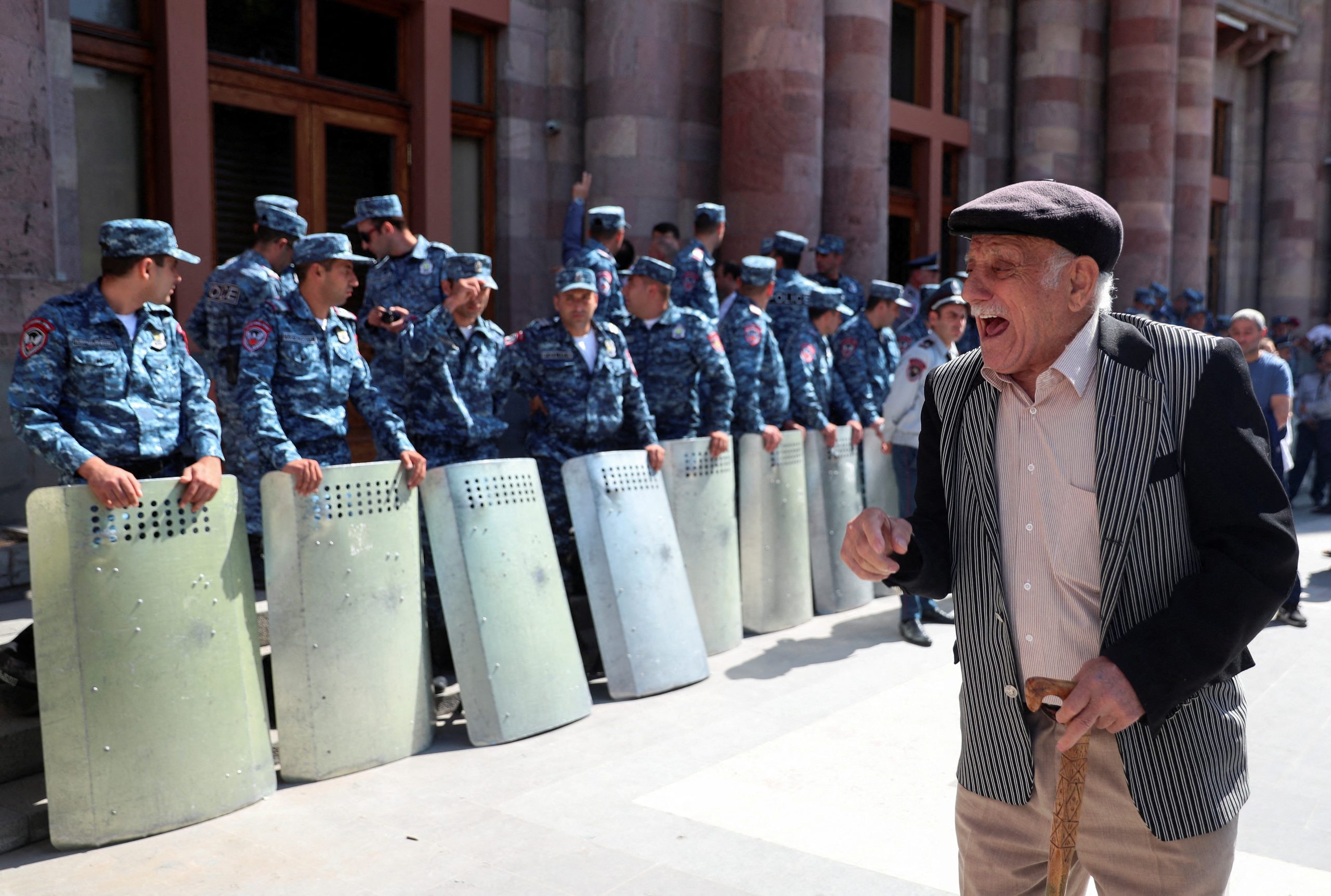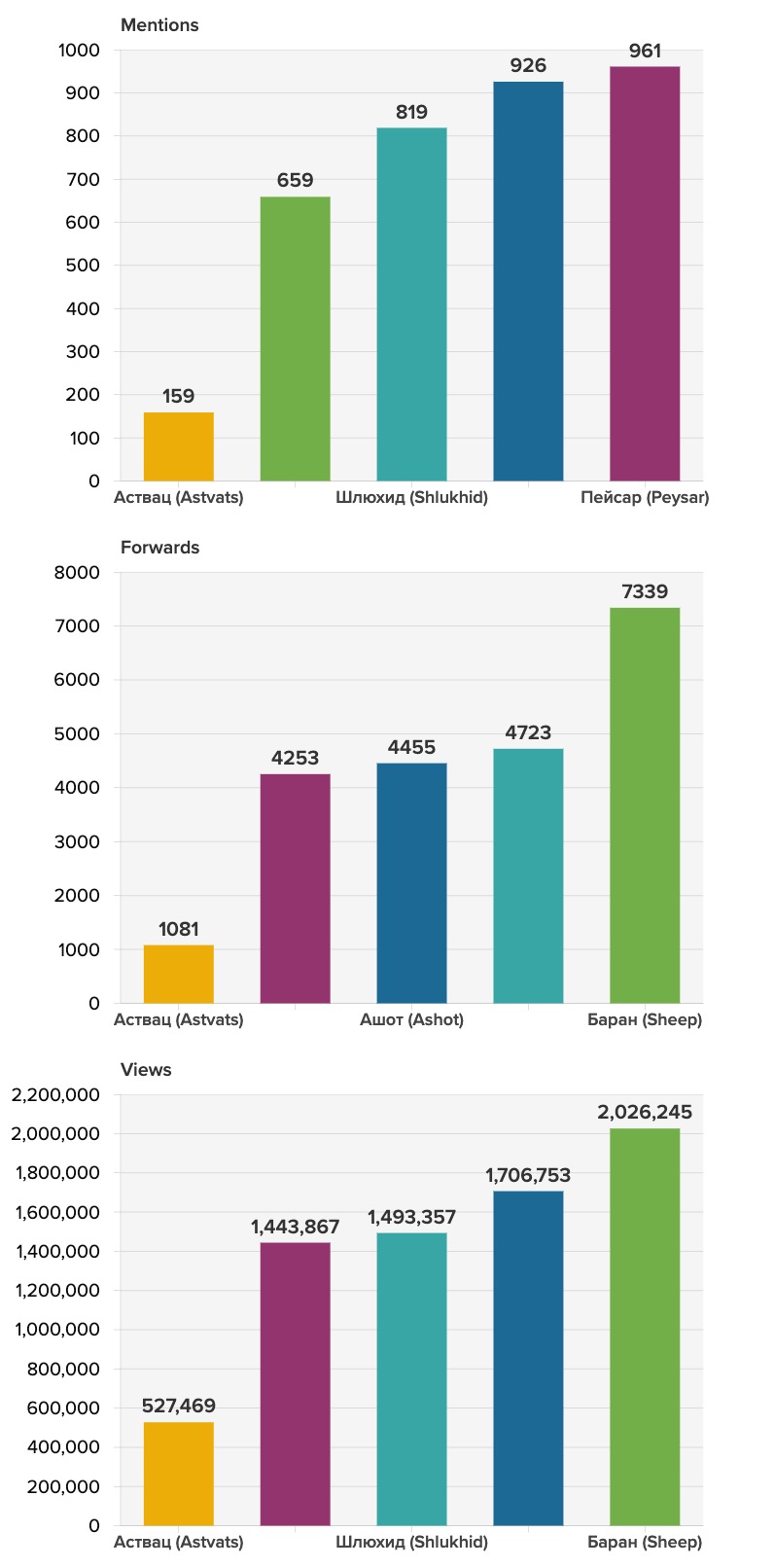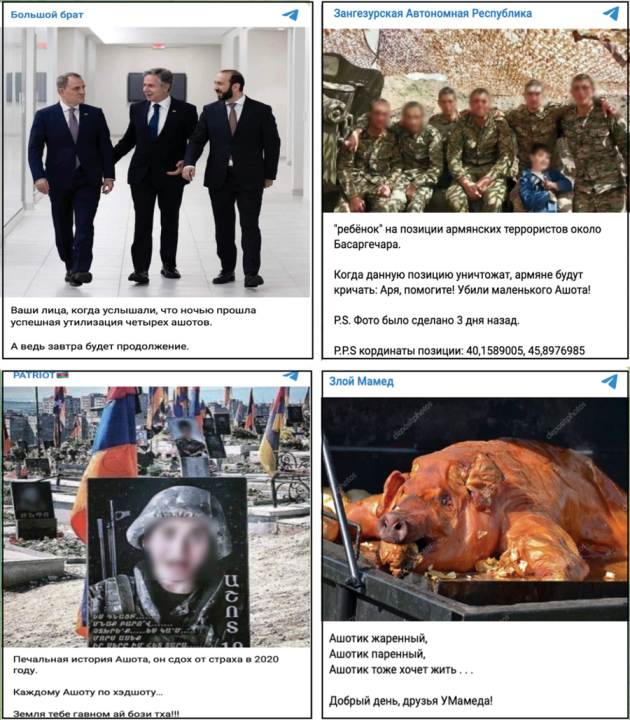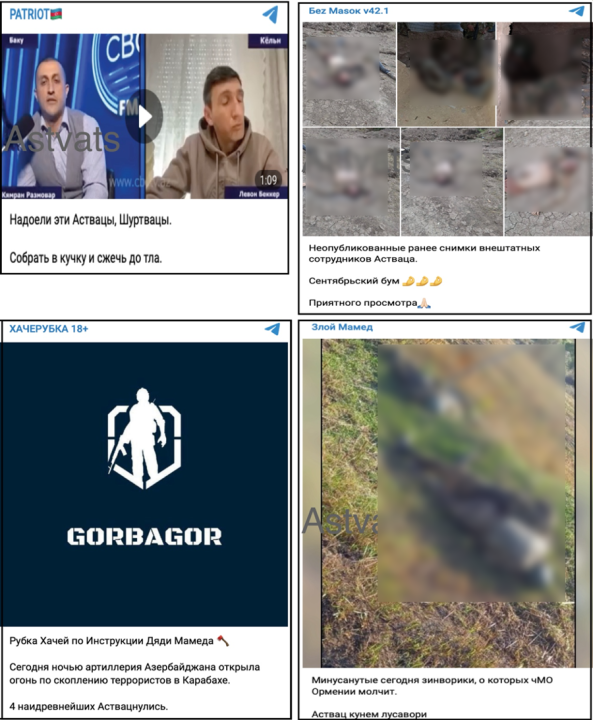Armenian and Azerbaijani Telegram channels incite violence against each other
Telegram channels routinely publish graphic footage and hate speech, fueling online outrage in a decades-old conflict
Armenian and Azerbaijani Telegram channels incite violence against each other

Banner: A protester reacts to the presence of law enforcement in Yerevan following the launch of a military operation by Azerbaijani forces against the region of Nagorno-Karabakh, September 20, 2023. (Source: Reuters/Irakli Gedenidze)
Editor’s note: this story contains slurs and derogatory terms, as well as links to graphic footage.
In the weeks prior to Azerbaijan’s September 2023 attack on the ethnic Armenian enclave of Nagorno-Karabakh, the DFRLab identified more than seventy Armenian and Azerbaijani Telegram accounts publishing hate speech and inciting violence against the opposing side. These channels routinely use dehumanizing language and celebrate acts of violence committed against their adversary.
For more than three decades, Armenia and Azerbaijan have been in conflict over the Nagorno-Karabakh region, experiencing two major wars. The first war lasted six years and ended in 1994, while a second war lasted six weeks in the autumn of 2020; additional clashes took place over a two-day period in September 2022. On September 19, 2023, Azerbaijan launched what it described as an “anti-terrorist” military operation in Nagorno-Karabakh, demanding a withdrawal of ethnic Armenian troops from the region, known as Artsakh in Armenian, as well as the dissolution of the Armenian Karabakh government. The following day, the Karabakh government agreed to disarm and disband its armed forces, as well as begin integration negotiations with Azerbaijan. According to the office of the Nagorno-Karabakh human rights ombudsman, the military operation resulted in the death of two hundred people, including ten civilians, as well as more than four hundred injuries; these numbers have not been independently confirmed.
Both nations increasingly use social media to target global audiences as well as each other. Since the 2020 Nagorno-Karabakh war, Telegram has become a significant vector for Armenians and Azerbaijanis to target each other with hate speech and terror-inducing content, including graphic photos and videos. The United Nations defines hate speech as “any kind of communication in speech, writing or behavior, that attacks or uses pejorative or discriminatory language with reference to a person or a group on the basis of who they are, in other words, based on their religion, ethnicity, nationality, race, color, descent, gender or other identity factor.”
In the context of hate speech within a conflict setting, the International Committee of the Red Cross has noted:
[T]he use of technologies has a considerable impact on the scale and speed at which harmful information reaches multiple target audiences online, and the effect it has on them. This is particularly concerning in crisis settings, where information can influence dynamics and behavior on the ground, as well as the types of risks and vulnerabilities that the communities and humanitarian responders involved have to address.
The DFRLab’s analysis revealed that hate speech targeting Armenian and Azerbaijani people is widely circulated on Telegram and that administrators of anonymous channels use dehumanizing language to fuel violence and justify killing their adversary. Posts frequently contained photos of dead soldiers from both sides, with the captions of such posts often endorsing or celebrating their deaths. The channels also target women and the LGBTQ+ community, including threats of sexual violence.
Methodology
The DFRLab focused on researching Telegram because of its wide popularity in the region and its lax enforcement of content policies, even though it formally prohibits calls for violence and hate speech. According to January 2023 research conducted by the analytics company Similar Web, Telegram is the most popular messaging app in Armenia, while in Azerbaijan it is in third place. Telegram’s popularity in Azerbaijan dates back to at least 2020, with research suggesting increased usage during the war that autumn, when it became a tool for engaging in hate speech, harassment, and disinformation.
Using the Telegram analytics tool TGStat, we identified sixty-eight Telegram channels – thirty-two pro-Azerbaijani and thirty-six pro-Armenian – targeting the opposing side. The creation dates of the channels range from April 2017 to June 2023. Six channels from the pro-Azerbaijan cluster and one from the pro-Armenia cluster were created during the second Nagorno-Karabakh war (September 27-November 10, 2020).
According to a TGStat query, the number of subscribers for the largest channel in each cluster increased after a round of military clashes in September 2022. For example, the subscriber base for the pro-Armenia channel VardanGukasyan increased from 59,229 to 132,991 on September 13, 2022, the day clashes erupted.

That same day, the number of subscribers to the pro-Azerbaijan channel Caliber grew from 33,313 to 48,495.

Weaponizing hate speech
After identifying the two clusters, the DFRLab used TG Collector, a tool that scrapes posts and feeds from the platform, to collect more than 200,000 posts across both Telegram channel clusters. Subsequently, we identified the six most widely used ethnonational slurs, which the Telegram channels employ to justify, incite, and celebrate acts of violence against the opposing side.

Posts containing “пейсары” (Peysars, or “humiliated person”) garnered the highest number of mentions within the pro-Armenian cluster, followed by posts with Ашот (Ashot, a name used to describe all Armenians). Posts mentioning Баран (Baran, or “sheep”) garnered the highest number of forwards, followed by posts containing “шлюхид” (Shluhkid, or “whore-martyr”). As for views, posts using Baran garnered over 2 million views, followed by posts with Ashot, with over 1.7 million views.

Despite the use of slurs and other derogatory terms derived from Armenian and Azerbaijani, the Telegram channels primarily publish in Russian, likely because it is commonly spoken in both countries.
One widely used anti-Armenian keyword, Ашот (Ashot), is a placeholder aim used to represent Armenian people collectively; many Telegram posts that used the keyword routinely called for the death of Armenians. For instance, one Telegram post by channel Большой брат (“Big Brother”) claimed, “There will be peace after the complete elimination of the Ashot statehood in the South Caucasus,” adding, “No ashots – no more problems!” Another post from the same channel shared a photo of Armenian Foreign Minister Ararat Mirzoyan and US Secretary of State Antony Blinken, both of whom are smiling, alongside Azerbaijani Foreign Minister Jeyhun Aziz oglu Bayramov, who is not smiling. The caption accompanying the photo read, “Your faces when you heard that four Ashots were successfully disposed of [killed] during the night. This will continue tomorrow.”
Calling Armenians Ashots and “eternally whining jackals” [“вечно скулящих шакалов”], Telegram channel Galib Efendi asserted that Armenians “should not exist not only in Karabakh, but even in the Caucasus.” Elsewhere, Telegram channel Зангезурская Автономная Республика (“Zangezyr Autonomous Republic”) published a photo allegedly of Armenian soldiers posing with a boy, accompanied with the caption, “Armenian terrorists near Basargechar have a ‘child’ at a military position. When this position is destroyed, the Armenians will shout: Arya, help! They killed little Ashot!” The post also contained coordinates for the military outpost in question, exposing the location for potential targeting. Separately, a post from the Telegram channel Patriot contained a photo of a headstone of a young Armenian soldier killed during military hostilities between Armenia and Azerbaijan in 2020 alongside the text, “The sad story of Ashot, he died of fear in 2020. Each Ashot gets a headshot…”
In some cases, pro-Azerbaijan channels celebrated the death of Armenians by comparing them with cooked meat. A post from Telegram channel Злой Мамед (“Angry Mamed”) featured an image of a roasted pig alongside the caption, “Little Ashot fried, little Ashot steamed, little Ashot also wanted to live.”

Another keyword widely used by pro-Azerbaijan Telegram channels when celebrating the death of Armenians is Аствац (Astvats), the Armenian word for “God.” As Islam is the majority religion in Azerbaijan and the vast majority of Armenians are Christians, this keyword is frequently used by Telegram channels in order to insult Christian Armenians. One post published by Patriot referred to Armenians as Astvats and stated that someone should collect them all and “burn [them] to the ground.” Separately, the Telegram channel Kolorit published graphic photos of dead Armenian soldiers with the caption, “Previously unpublished pictures of Astvats freelancers… Please enjoy🙏.” Telegram channel Khacherubka 18+ posted that Azerbaijani artillery opened fire on Armenian “terrorists” in Karabakh and four of them “were sent to Astvats [God].” Elsewhere, Angry Mamed published a disturbing photo of an allegedly killed Armenian soldier, with the caption, “Fuck Astvats” (“Аствац кунем лусавори”).

Pro-Armenian channels, meanwhile, actively engaged in hate speech, often using the word Baran (“Баран,” meaning “sheep”) or employing a sheep emoji when referring to Azerbaijanis, implying them to be stupid and submissive. In one case, the channel Hay Zenq (“Armenian Weapon”) published photos and personal information of an allegedly Azerbaijani woman. The post related to an alleged chat with the woman, with a caption reading, “It’s just time for you to accept that even your female sheep don’t want peysars that stink like male sheep.” The post concluded, “Azeris are happy to give themselves [sexually] to us.”

As with the pro-Azerbaijan channels, pro-Armenia channels also celebrated the death of soldiers from the opposing side. A vivid case of directly targeting an Azerbaijani audience can be found on channel Ищи своих 21+ (“Find your people AZ 21+”), whose description reads, “Here Azerbaijanis can find their [dead] relatives. Throw the corpses of Azeris here.” In one instance, the channel published graphic footage allegedly of a dead Azerbaijani soldier, with the caption, “The sheep died, the head is gone.” The caption used the Turkish word for gone, yok; when engaging in hate speech, channels on both sides of the conflict often employ languages other than Russian that are understood by the opposing side. In Armenia, the general perception of both Turks and Azerbaijanis is often highly negative, and Armenians sometimes refer to Azerbaijanis as “Turks” as an epithet. The use of Turkish words in pro-Armenia channels projects the same derogatory attitude as does the use of Azerbaijani words.
Elsewhere, the channel ֍ Հ:Ա:Պ (“Armenian Aryan State”) often engages in tactics to vilify Azerbaijanis by inciting violence and hate, including the sharing of extremely graphic footage depicting the mutilation of soldiers. One such video showed a captured Azerbaijani soldier having his ear cut off, with the caption making light of it: “Disposal of a still-warm Azeri sheep 🔪🇦🇿.”

The pro-Armenia channel Катакомбы Лабиринты (“Catacombs Labyrinths”) posted a video of a disabled Azerbaijani war veteran sitting with an infant and speaking about his experiences during the 2020 Nagorno Karabakh war. A caption described the veteran and child in derogatory terms. “Another participant of the war against Artsakh, a mini Shlyukhid [“whore-martyr”], complains that he is not receiving a pension, medical treatment, and cannot feed his piç [Turkish for “bastard”]. The Peysar says that if this continues, he will be forced to personally eat his dumb child.”
The channel Armenian Radical posted content targeting Azerbaijan’s LGBTQ+ community, including one post mocking journalist and LGBTQ+ activist Ismail Djalilov. “Azerbaijani ‘journalist’ Ismail Djalilov, with an LGBT emblem around his neck – because why not promote his own LGBTQ+ values – interviewed the pro-Armenian Austrian MP, Stefan Schennach,” the caption stated. “Look at the fat scum, how he constantly interrupts the deputy and does not let him say anything. The MP said right to this pig’s snout that Artsakh is the ancestral land of Armenians. Acting like a Baran.”
Armenian Aryan State has also posted anti-LGBTQ+ content, including a screenshot showing what appears to be a transgender sex worker offering their services in Baku. “Another peysar after the war does not have enough money, and he changed his gender, and now he is selling ass as an escort,” the screenshot’s caption claimed. “More proof that Azergayjan [a pejorative portmanteau of “Azerbaijan” and “gay”] are a people of trade: they trade in everything and everywhere.”
Pro-Azerbaijan channels also targeted Armenia’s LGBTQ+ community, as well as Armenian women. A post by Telegram channel Без Тормозов (“Without Brakes”) contained a video of Lilit Martirosyan, the first transgender woman in Armenia to update her gender on her passport, speaking in the Armenian Parliament. The post alleged that Armenians are disrespectful because Sodom and Gomorrah, two ancient cities that were described in religious texts as wicked, are purported promoted at the state level, and that Martirosyan’s speech in parliament confirms it. The same channel also used threatening language against female Armenian soldiers, suggesting they might become targets of sexual violence by Azerbaijani troops.
Channels across the Armenia-Azerbaijan divide targeting each other
The DFRLab also collected a total of 298,495 messages from seventy-two channels in both clusters over a period beginning with creation dates through July 14, 2023. A network analysis of the dataset revealed that a subset of the channels targeted each other by forwarding or quoting each other’s posts. Eighteen of the pro-Azerbaijan channels mentioned six of the pro-Armenia channels 273 times, while fourteen pro-Armenia channels mentioned twenty of the pro-Azerbaijan channels 267 times. Among the pro-Azerbaijani cluster, the pro-Armenian channels Баграмян 26 [“Bagramyan 26”], SisMasis, and Mika Badalya cumulatively garnered 217 out 273 Armenian channel mentions. And among the pro-Armenia cluster, the pro-Azerbaijan channels Девичья Башня [“Maiden’s Tower”], Большой брат [“Big Brother”], and Caliber garnered a total of 188 mentions.
Generally, posts that referenced an opposing Telegram channel displayed an argumentative nature, suggesting awareness that they were keeping an eye on each other. For example, a multiple-choice poll shared on a pro-Armenia included the option, “Azeris click here.” Later, a pro-Azerbaijani channel forwarded the post.
In another instance, a post shared by pro-Armenia channel SisMasis showed drone footage of the Turkish city of Antakya in ruins following the deadly February 2023 earthquake, alongside the caption, “Antakya after a beautiful earthquake.” The post was later quoted by a pro-Azerbaijani channel, UDudaka, which in turn advocated violence against Armenians. “Then they wonder why they are being slaughtered,” it wrote. “The right thing is slaughtering. Well deserved.”

Another pro-Armenia channel forwarded a post from a pro-Azerbaijan channel discussing the suicide rate among war veterans and calling for the Azerbaijani government to increase veteran support. In response, the pro-Armenia channel wrote, “Mr. President, stop the flash mob of minishluhyd [mini whore-martyrs] suicides.”
![Screencap of a post from a pro-Armenian channel in which it forwarded a post from a pro-Azerbaijan channel and referred to its subject – an Azerbaijani veteran who died by suicide – as a “minishluhyd” [“mini whore-martyr”].](https://dfrlab.org/wp-content/uploads/sites/3/2023/09/image-34.png)
The DFRLab also analyzed content-sharing patterns within each cluster. Thirty-six channels in the pro-Armenia cluster amplified each other 15,027 times, while thirty-two channels in the pro-Azerbaijan cluster amplified each other 13,389 times. Within the pro-Armenia cluster, the channels Armenian Military Portal, Spitak Arch, Armenian Radical, Republic of Artsakh, and Bagramyan 26 received the most amplification; in the pro-Azerbaijan cluster, the channels Without Brakes, Maiden’s Tower, Caliber, Caucasian Bureau, and Black Chat topped the list.
Even though hate speech and advocating violence are technically a violation of Telegram’s content policies, hostile actors in conflict-affected regions such as the South Caucasus still use the platform to amplify these forms of highly inflammatory rhetoric. By exploring derogatory Armenian and Azerbaijani terms used to target each other on Telegram, our research demonstrates how the bitter conflict between Armenia and Azerbaijan over Nagorno-Karabakh continues to play out online, further exacerbating the dehumanization of both sides.
Cite this case study:
Givi Gigitashvili, “Armenian and Azerbaijani Telegram channels incite violence against each other,” Digital Forensic Research Lab (DFRLab), September 21, 2023, https://dfrlab.org/2023/09/21/armenian-and-azerbaijani-telegram-channels-incite-violence-against-each-other.

